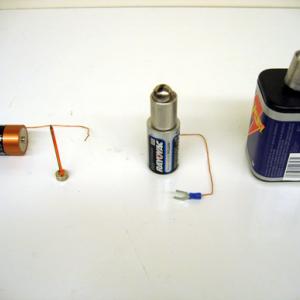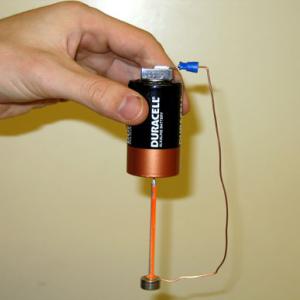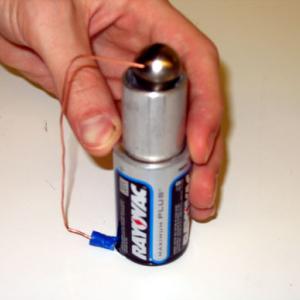College of Liberal Arts & Sciences
5H40.53 - Homopolar Motor
Place the square magnet on the negative end of the "D" cell battery. Also, attach the crimp connector part of the copper wire to the that magnet. Attach the small neodymium disk magnet to the head of the nail and center as much as possible. Then hang the nail assembly from the positive end of the "D" cell by the point of the nail (this gives a very frictionless bearing). Tilt the battery so that the copper wire comes into contact with the magnet that is on the head of the nail. When contact is made the nail assembly will rotate.
A simple homopolar motor is made by attaching a magnet to the negative end of a AA battery and dropping the spiral copper spring over the battery. Place a small dimple in the positive pole of the magnet to keep the spring centered while it rotates.
The linear homopolar motor consists of two cylindrical magnets placed so that like poles face each other inside the copper tube. Place this onto the rails. Turn on the power supply and the copper tube will roll one way. Switch the direction of the current and the tube will roll the other way. You can also switch the direction the tube will roll by reversing the magnets in the tube. Remember that the like poles must face each other when reversing the magnets.
A variation of this is to put the adapter/spacer assembly onto the positive end of the "D" cell and place the spherical neodymium magnet in the cup. Touching the magnet with the copper wire will cause the spherical magnet to rotate.
A 6 volt lantern battery may be substituted for the "D" cell by using the appropriate adapter/spacer assembly.
Caution: The copper wire will get quite hot if run or shorted for extended periods.
- Keith Zengel, "The Handheld and Hand-Powered Homopolar Generator", TPT, Vol. 56, #1, Jan. 2018, p. 61.
- Stanisław Bednarek, "Amazing Vibrations Within the Homopolar Motor", TPT, Jan. 2018, Vol. 54, #1, Jan. 2018, p. 47.
- H. K. Wong, "Motional Mechanisms of Homopolar Motors & Rollers", TPT, Vol. 47, #7, Oct. 2009, p. 463.
- H. K. Wong, "Levitated Homopolar Motor", TPT, Vol. 47, #2, Feb. 2009, p. 124.
- Norihiro Sugimoto and Hideo Kawada, "The Homopolar Motor and Its Evolution", TPT, Vol. 44, #5, May 2006, p. 313.
- Robert Beck Clark, "The Simplest Generator from the Simplest Motor?", TPT, Vol. 44, #2, Feb. 2006, p. 121.
- David Kagan, "Simple Demonstration of the Earth's Magnetic Field", TPT, Vol. 43, #2, Feb. 2005, p. 68.
- Samuel Derman, "Upright Homopolar Motor", TPT, Vol. 43, #2, Feb. 2005 p. 68.
- Christopher Chiaverina, "The Simplest Motor?", TPT, Vol. 42, #9, Dec. 2004, p. 553.
- Bill Layton, Martin Simon, "A Different Twist on the Lorentz Force and Faraday's Law", TPT, Vol. 36, # 8, Nov. 1998, p. 474.
- A. K. T. Assis and J. P. M. C. Chaib, "Ampère’s Motor: Its History and the Controversies Surrounding its Working Mechanism", AJP, Vol. 80, #11, Nov. 2012, p. 990.
- Jorge Guala-Valverde, Pedro Mazzoni, and Ricardo Achilles, "The Homopolar Motor: A True Relativistic Engine", AJP, Vol. 70, #10, Oct. 2002, p. 1052.
- Stanislaw Bednarek, "Unipolar Motors and their Application to the Demonstration of Magnetic Field Properties", AJP, Vol. 70, #4, Apr. 2002, p. 455.
- Robert D. Eagleton and Martin N. Kaplan, "The Radial Magnetic Field Homopolar Motor", AJP, Vol. 56, #9, Sept. 1988, p. 858.
- Robert D. Eagleton, "Two Laboratory Experiments Involving the Homopolar Generator", AJP, Vol. 55, #7, July 1987, p. 621.
- A. K. Das Gupta, "Unipolar Machines. Association of the Magnetic Field with the Field-Producing Magnet", AJP, Vol. 31, #6, June 1963, p. 428.
- Annabel Edwards, "Magnet Car", Popular Science, Vol. 288, #4, July/Aug. 2016, p. 90.
- Jorge Guala-Valverde and Ricardo Achilles "A Manifest Failure of Grassmann's Force", Journal of Gravitational Physics, Vol. 2, #1, 2008.
- Jorge Guala-Valverde and Ricardo Achilles, "A Manifest Failure of Grassmann's Force", Apeiron, Vol. 15, #2, Apr. 2008, p. 202.
- Karen Romano Young and Matthew Rakola, "Mini-Spinners", Try This! 50 Fun Experiments for the Mad Scientist in You, National Geographic Kids, p. 135 - 136.
- David Kutliroff, "88. The Unipole Motor", 101 Classroom Demonstrations and Experiment For Teaching Physics, p. 196 - 197.
- Windell Oskay, "How to Make the Simplest Electric Motor", Evil Mad Scientist, 08/07/2006.
- "The Electric Motor: The Motor Effect", School Science.
- Cy Tymony, "Sneaky Motor V", Sneakiest Uses for Everyday Things, p. 67 - 68.
- Cy Tymony, "Sneaky Motor IV", Sneakiest Uses for Everyday Things, p. 64 - 66.
- Bobby Mercer, "Super Speed Motor", Junk Drawer Physics, p. 139.
Disclaimer: These demonstrations are provided only for illustrative use by persons affiliated with The University of Iowa and only under the direction of a trained instructor or physicist. The University of Iowa is not responsible for demonstrations performed by those using their own equipment or who choose to use this reference material for their own purpose. The demonstrations included here are within the public domain and can be found in materials contained in libraries, bookstores, and through electronic sources. Performing all or any portion of any of these demonstrations, with or without revisions not depicted here entails inherent risks. These risks include, without limitation, bodily injury (and possibly death), including risks to health that may be temporary or permanent and that may exacerbate a pre-existing medical condition; and property loss or damage. Anyone performing any part of these demonstrations, even with revisions, knowingly and voluntarily assumes all risks associated with them.



